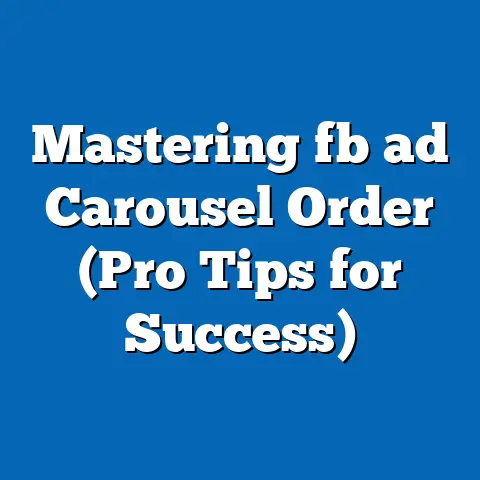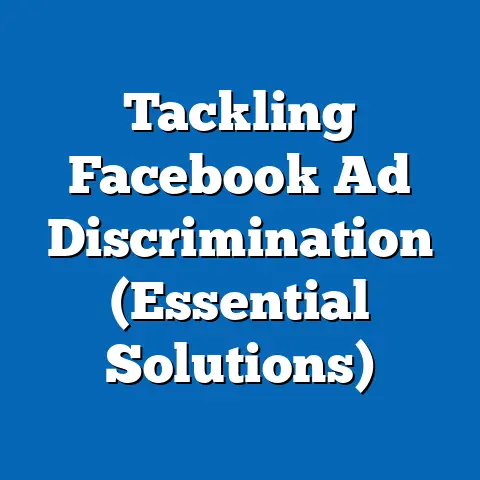Mastering Facebook Ads Comment Moderation (Essential Guide)
Facebook has become a digital playground for pet brands. I’ve seen firsthand how businesses in this niche can leverage the platform to connect with passionate pet owners, showcase their products, and build thriving communities. But just like any playground, things can get messy. That’s where comment moderation comes in. It’s not just about deleting negative remarks; it’s about nurturing a positive, engaging environment that reflects your brand’s values and ultimately drives sales.
Think of it this way: your Facebook ad is like a storefront window. The comments section is the sidewalk in front. Do you want a clean, inviting space where potential customers feel welcome and informed? Or a chaotic mess of spam and negativity that sends them running?
In this guide, I’ll walk you through the essentials of mastering comment moderation on Facebook ads, specifically tailored for pet brands. We’ll cover everything from setting up a strategy to analyzing your results, ensuring your Facebook presence is as delightful as the pets you cater to.
Section 1: Understanding the Importance of Comment Moderation
Comment moderation, in the context of Facebook ads, is the process of monitoring, filtering, and responding to comments left on your advertisements. It goes beyond simply deleting spam; it encompasses creating a positive and productive conversation around your brand.
Why is it so important?
- Brand Perception: Your comments section is a direct reflection of your brand. Positive, helpful interactions build trust and credibility. I’ve seen brands completely transform their image just by actively engaging in their comments and addressing concerns.
- Customer Trust: Pet owners are notoriously passionate and discerning. They want to know they’re buying from a brand that cares about their furry (or scaled, or feathered) companions. Addressing concerns promptly and genuinely builds trust.
- Engagement: A well-moderated comments section encourages further interaction. People are more likely to participate when they see others having positive experiences and receiving helpful responses. Think of it as social proof in action.
- Ad Effectiveness: Believe it or not, comment moderation can directly impact your ad performance. A negative comments section can deter potential customers, leading to lower click-through rates and conversions. On the other hand, a positive, engaging comments section can boost your ad’s perceived value and encourage more people to click.
Real-World Examples:
I’ve worked with a local pet supply store that initially ignored their Facebook ad comments. They were running ads for dog toys, but the comments were filled with complaints about shipping delays and product quality. Their ad performance plummeted. After implementing a comment moderation strategy, responding to complaints, and offering solutions, they saw a significant increase in ad engagement and sales.
Another example is a national pet food brand that uses comment moderation to build community. They actively respond to positive comments, share pet care tips, and even run contests within the comments section. This has created a loyal following and boosted their brand awareness.
The Risks of Neglecting Comment Moderation:
Ignoring your comments section is like leaving your store unattended. You’re inviting trouble.
- Negative Comments Spiral: Unaddressed negative comments can quickly escalate, damaging your brand reputation.
- Spam and Scams: Unmoderated comments sections are magnets for spam and scams, which can erode trust and even put your customers at risk.
- Missed Opportunities: You’re missing out on valuable opportunities to connect with customers, gather feedback, and address concerns.
Takeaway: Comment moderation is not just a chore; it’s an investment in your brand’s image, customer relationships, and ultimately, your bottom line.
Section 2: Setting Up a Comment Moderation Strategy
A reactive approach to comment moderation is like playing whack-a-mole. You’ll be constantly putting out fires instead of proactively shaping the conversation. That’s why a well-defined strategy is crucial. Here’s how to set one up for your pet brand:
-
Establishing Guidelines:
- Create a Comment Policy: This document outlines the rules of engagement for your comments section. It should clearly state what types of comments are acceptable and what types will be removed (e.g., hate speech, spam, irrelevant content).
- Reflect Brand Values: Your comment policy should align with your brand’s values. If you’re a brand that promotes positive reinforcement training, your policy should discourage comments that advocate for punishment-based methods.
- Be Specific: Avoid vague language. Clearly define what constitutes unacceptable behavior.
- Make it Accessible: Post your comment policy prominently on your Facebook page and even link to it in your ad copy.
-
Training Moderators:
-
Internal Team: If you’re using an internal team, provide them with thorough training on your comment policy, brand voice, and best practices for handling different types of comments.
- External Agency: If you’re outsourcing, ensure the agency understands your brand, target audience, and comment policy.
- Consistency is Key: All moderators should be on the same page regarding how to handle comments. This ensures a consistent and professional experience for your customers.
-
Choosing Tools:
-
Facebook’s Built-in Tools: Facebook offers basic moderation tools, such as keyword blocking and comment hiding. These are a good starting point.
- Third-Party Tools: Several third-party tools offer more advanced features, such as sentiment analysis, automated moderation, and reporting. Some popular options include:
- Hootsuite: Offers a comprehensive social media management platform with comment moderation features.
- Sprout Social: Another popular social media management tool with robust moderation capabilities.
- Brand24: Focuses on brand monitoring and sentiment analysis, allowing you to track mentions and identify potential issues.
- Pet-Specific Considerations: Look for tools that allow you to categorize comments based on pet type (dog, cat, bird, etc.) or topic (nutrition, training, health). This can help you prioritize and personalize your responses.
Establishing Guidelines:
- Create a Comment Policy: This document outlines the rules of engagement for your comments section. It should clearly state what types of comments are acceptable and what types will be removed (e.g., hate speech, spam, irrelevant content).
- Reflect Brand Values: Your comment policy should align with your brand’s values. If you’re a brand that promotes positive reinforcement training, your policy should discourage comments that advocate for punishment-based methods.
- Be Specific: Avoid vague language. Clearly define what constitutes unacceptable behavior.
- Make it Accessible: Post your comment policy prominently on your Facebook page and even link to it in your ad copy.
-
Training Moderators:
-
Internal Team: If you’re using an internal team, provide them with thorough training on your comment policy, brand voice, and best practices for handling different types of comments.
- External Agency: If you’re outsourcing, ensure the agency understands your brand, target audience, and comment policy.
- Consistency is Key: All moderators should be on the same page regarding how to handle comments. This ensures a consistent and professional experience for your customers.
-
Choosing Tools:
-
Facebook’s Built-in Tools: Facebook offers basic moderation tools, such as keyword blocking and comment hiding. These are a good starting point.
- Third-Party Tools: Several third-party tools offer more advanced features, such as sentiment analysis, automated moderation, and reporting. Some popular options include:
- Hootsuite: Offers a comprehensive social media management platform with comment moderation features.
- Sprout Social: Another popular social media management tool with robust moderation capabilities.
- Brand24: Focuses on brand monitoring and sentiment analysis, allowing you to track mentions and identify potential issues.
- Pet-Specific Considerations: Look for tools that allow you to categorize comments based on pet type (dog, cat, bird, etc.) or topic (nutrition, training, health). This can help you prioritize and personalize your responses.
Training Moderators:
Internal Team: If you’re using an internal team, provide them with thorough training on your comment policy, brand voice, and best practices for handling different types of comments.
Choosing Tools:
Facebook’s Built-in Tools: Facebook offers basic moderation tools, such as keyword blocking and comment hiding. These are a good starting point.
- Hootsuite: Offers a comprehensive social media management platform with comment moderation features.
- Sprout Social: Another popular social media management tool with robust moderation capabilities.
- Brand24: Focuses on brand monitoring and sentiment analysis, allowing you to track mentions and identify potential issues.
My Experience:
I remember working with a pet grooming business that was overwhelmed by the volume of comments on their Facebook ads. They were spending hours each day manually moderating comments. By implementing a third-party tool with automated moderation features, they were able to significantly reduce their workload and focus on more strategic tasks.
Takeaway: A proactive comment moderation strategy requires clear guidelines, trained moderators, and the right tools. This will help you create a positive and engaging environment for your customers and protect your brand reputation.
Section 3: Best Practices for Moderating Comments
Now that you have a strategy in place, let’s dive into the nitty-gritty of moderating comments. Here are some best practices specifically tailored for pet brands:
-
Responding to Positive Comments:
- Acknowledge and Thank: Always acknowledge and thank customers who leave positive feedback. A simple “Thank you for sharing your experience!” can go a long way.
- Personalize Your Response: Avoid generic responses. Tailor your reply to the specific comment. For example, if someone says their dog loves your new chew toy, you could say, “We’re so glad to hear Buster is enjoying his new toy! What’s his favorite thing about it?”
- Share Pet Owner Experiences: Encourage customers to share photos and stories of their pets using your products. This creates social proof and fosters a sense of community.
-
Addressing Negative Comments:
-
Respond Promptly: Don’t let negative comments fester. Respond as quickly as possible, ideally within 24 hours.
- Stay Professional: Even if the commenter is being rude or unreasonable, maintain a professional and courteous tone.
- Acknowledge the Issue: Let the commenter know you understand their concern.
- Offer a Solution: Provide a clear and concise solution to the problem. This could involve offering a refund, replacement, or simply providing more information.
- Take it Offline: If the issue is complex or requires sensitive information, offer to take the conversation offline (e.g., via email or phone).
- Don’t Delete (Unless Necessary): Only delete comments that violate your comment policy (e.g., hate speech, spam). Deleting legitimate complaints can make you look like you’re trying to hide something.
-
Encouraging Engagement:
-
Ask Questions: Prompt discussions by asking questions related to your products or pet care in general. For example, “What’s your dog’s favorite trick?” or “What are your tips for dealing with shedding?”
- Share Pet Care Tips: Provide valuable content that your audience will appreciate. This could include tips on training, nutrition, grooming, or health.
- Run Contests and Giveaways: Encourage participation by running contests and giveaways. Ask people to share photos of their pets or tag their friends.
-
Utilizing Humor and Personality:
-
Inject Humor: Where appropriate, inject humor into your responses. This can make your brand more relatable and engaging.
- Show Personality: Let your brand’s personality shine through. Are you playful and quirky? Serious and informative? Be authentic and genuine.
- Embrace the Pet Theme: Use pet-related puns and idioms. For example, “We’re paws-itively thrilled to hear you’re enjoying our products!”
Responding to Positive Comments:
- Acknowledge and Thank: Always acknowledge and thank customers who leave positive feedback. A simple “Thank you for sharing your experience!” can go a long way.
- Personalize Your Response: Avoid generic responses. Tailor your reply to the specific comment. For example, if someone says their dog loves your new chew toy, you could say, “We’re so glad to hear Buster is enjoying his new toy! What’s his favorite thing about it?”
- Share Pet Owner Experiences: Encourage customers to share photos and stories of their pets using your products. This creates social proof and fosters a sense of community.
-
Addressing Negative Comments:
-
Respond Promptly: Don’t let negative comments fester. Respond as quickly as possible, ideally within 24 hours.
- Stay Professional: Even if the commenter is being rude or unreasonable, maintain a professional and courteous tone.
- Acknowledge the Issue: Let the commenter know you understand their concern.
- Offer a Solution: Provide a clear and concise solution to the problem. This could involve offering a refund, replacement, or simply providing more information.
- Take it Offline: If the issue is complex or requires sensitive information, offer to take the conversation offline (e.g., via email or phone).
- Don’t Delete (Unless Necessary): Only delete comments that violate your comment policy (e.g., hate speech, spam). Deleting legitimate complaints can make you look like you’re trying to hide something.
-
Encouraging Engagement:
-
Ask Questions: Prompt discussions by asking questions related to your products or pet care in general. For example, “What’s your dog’s favorite trick?” or “What are your tips for dealing with shedding?”
- Share Pet Care Tips: Provide valuable content that your audience will appreciate. This could include tips on training, nutrition, grooming, or health.
- Run Contests and Giveaways: Encourage participation by running contests and giveaways. Ask people to share photos of their pets or tag their friends.
-
Utilizing Humor and Personality:
-
Inject Humor: Where appropriate, inject humor into your responses. This can make your brand more relatable and engaging.
- Show Personality: Let your brand’s personality shine through. Are you playful and quirky? Serious and informative? Be authentic and genuine.
- Embrace the Pet Theme: Use pet-related puns and idioms. For example, “We’re paws-itively thrilled to hear you’re enjoying our products!”
Addressing Negative Comments:
Respond Promptly: Don’t let negative comments fester. Respond as quickly as possible, ideally within 24 hours.
Encouraging Engagement:
Ask Questions: Prompt discussions by asking questions related to your products or pet care in general. For example, “What’s your dog’s favorite trick?” or “What are your tips for dealing with shedding?”
Utilizing Humor and Personality:
Inject Humor: Where appropriate, inject humor into your responses. This can make your brand more relatable and engaging.
Common Pitfalls:
- Getting Defensive: It’s easy to take negative comments personally, but resist the urge to get defensive.
- Ignoring Comments: The worst thing you can do is ignore comments altogether.
- Using Generic Responses: Avoid using canned responses that sound impersonal and insincere.
My Insight:
I once saw a pet brand completely turn around a negative situation by responding to a complaint with humor and empathy. A customer had complained about a damaged product, and the brand responded with a witty apology and offered a free replacement. The customer was so impressed with the response that they became a loyal advocate for the brand.
Takeaway: Effective comment moderation involves a combination of responsiveness, professionalism, and personality. By following these best practices, you can create a positive and engaging community around your pet brand.
Section 4: Measuring the Success of Comment Moderation
You’re putting in the effort to moderate your comments, but how do you know if it’s actually working? Measuring the success of your comment moderation efforts is crucial for refining your strategy and maximizing your ROI. Here’s what to look for:
-
Engagement Metrics:
- Likes: Track the number of likes your comments receive. This indicates whether your responses are resonating with your audience.
- Shares: Monitor the number of shares your comments receive. This shows that your comments are valuable enough for people to share with their networks.
- Responses: Track the number of responses to your comments. This indicates whether you’re sparking conversations and encouraging engagement.
- Click-Through Rate (CTR): While not directly tied to the comment itself, a positive and engaging comment section can indirectly improve your ad’s CTR.
-
Sentiment Analysis:
-
Overall Sentiment: Use sentiment analysis tools to gauge the overall sentiment of the comments on your ads. Are people generally positive, negative, or neutral?
- Identify Trends: Look for trends in the sentiment. Are there specific products or topics that consistently generate positive or negative feedback?
- Address Negative Sentiment: If you identify a significant amount of negative sentiment, investigate the root cause and take steps to address it.
-
Adjusting Strategies:
-
Data-Driven Decisions: Use the data you collect to make informed decisions about your comment moderation strategy.
- Experiment and Iterate: Don’t be afraid to experiment with different approaches and see what works best for your brand.
- Continuous Improvement: Comment moderation is an ongoing process. Continuously monitor your results and refine your strategy to improve your performance.
Engagement Metrics:
- Likes: Track the number of likes your comments receive. This indicates whether your responses are resonating with your audience.
- Shares: Monitor the number of shares your comments receive. This shows that your comments are valuable enough for people to share with their networks.
- Responses: Track the number of responses to your comments. This indicates whether you’re sparking conversations and encouraging engagement.
- Click-Through Rate (CTR): While not directly tied to the comment itself, a positive and engaging comment section can indirectly improve your ad’s CTR.
-
Sentiment Analysis:
-
Overall Sentiment: Use sentiment analysis tools to gauge the overall sentiment of the comments on your ads. Are people generally positive, negative, or neutral?
- Identify Trends: Look for trends in the sentiment. Are there specific products or topics that consistently generate positive or negative feedback?
- Address Negative Sentiment: If you identify a significant amount of negative sentiment, investigate the root cause and take steps to address it.
-
Adjusting Strategies:
-
Data-Driven Decisions: Use the data you collect to make informed decisions about your comment moderation strategy.
- Experiment and Iterate: Don’t be afraid to experiment with different approaches and see what works best for your brand.
- Continuous Improvement: Comment moderation is an ongoing process. Continuously monitor your results and refine your strategy to improve your performance.
Sentiment Analysis:
Overall Sentiment: Use sentiment analysis tools to gauge the overall sentiment of the comments on your ads. Are people generally positive, negative, or neutral?
Adjusting Strategies:
Data-Driven Decisions: Use the data you collect to make informed decisions about your comment moderation strategy.
Tools for Measurement:
- Facebook Insights: Provides basic data on engagement metrics.
- Third-Party Social Media Analytics Tools: Offer more advanced analytics and sentiment analysis features.
- Manual Review: Sometimes, the best way to understand the impact of your comment moderation is to simply read through the comments and see what people are saying.
Example Scenario:
Let’s say you’re running an ad for a new brand of cat food. You notice that the comments section is filled with questions about the ingredients. You respond promptly and provide detailed information about the ingredients and their benefits. As a result, you see a significant increase in positive sentiment and engagement. This indicates that your comment moderation efforts are working.
Takeaway: Measuring the success of your comment moderation efforts is essential for refining your strategy and maximizing your ROI. By tracking engagement metrics, analyzing sentiment, and using data to make informed decisions, you can ensure that your comment moderation efforts are contributing to your overall marketing goals.
Section 5: Case Studies of Successful Pet Brands
Let’s take a look at some real-world examples of pet brands that have effectively implemented comment moderation in their Facebook ad campaigns:
- Chewy: This online pet retailer is known for its exceptional customer service. They actively monitor their Facebook ad comments and respond to inquiries and complaints promptly and professionally. They also use the comments section to share pet care tips and run contests.
- Hill’s Pet Nutrition: This pet food brand uses comment moderation to educate customers about the importance of proper nutrition for their pets. They respond to questions about ingredients and provide valuable information about pet health.
- BarkBox: This subscription box service for dogs uses comment moderation to build a strong community among its customers. They encourage people to share photos of their dogs enjoying their BarkBox and engage in conversations about dog ownership.
Key Tactics Used:
- Personalized Responses: All of these brands prioritize personalized responses over generic ones.
- Proactive Engagement: They don’t just react to comments; they actively seek out opportunities to engage with their audience.
- Community Building: They use the comments section to foster a sense of community among their customers.
- Transparency: They are transparent about their products and practices, which builds trust and credibility.
Challenges Faced:
- Volume of Comments: Managing a high volume of comments can be challenging.
- Negative Sentiment: Dealing with negative comments requires patience and professionalism.
- Time Commitment: Effective comment moderation requires a significant time commitment.
Outcomes Achieved:
- Improved Brand Reputation: These brands have built strong reputations for customer service and community engagement.
- Increased Customer Loyalty: Their customers are loyal and engaged, which translates to repeat business.
- Higher Ad Performance: Their ads perform well because they are supported by a positive and engaging comments section.
Inspiration for Other Pet Brands:
These examples demonstrate that effective comment moderation is not just about managing negative comments; it’s about building relationships with your customers and creating a positive brand experience. By following their lead, other pet brands can enhance their comment moderation strategies and achieve similar results.
My Observation:
What I’ve noticed about these successful brands is their genuine love for animals shines through in their interactions. It’s not just about selling products; it’s about connecting with pet owners on a personal level.
Takeaway: These case studies highlight the importance of personalized responses, proactive engagement, community building, and transparency in comment moderation. By adopting these tactics, pet brands can create a positive and engaging environment for their customers and improve their overall marketing performance.
Conclusion
Mastering comment moderation on Facebook ads is no longer optional for pet brands; it’s essential. It’s the key to unlocking a positive brand image, fostering genuine community engagement, and ultimately driving sales in a competitive digital landscape.
We’ve covered a lot in this guide, from understanding the importance of comment moderation to setting up a strategy, implementing best practices, measuring your success, and learning from real-world examples.
Remember, comment moderation is not just about deleting negative comments; it’s about creating a positive and engaging environment for your customers. It’s about building relationships, fostering community, and showcasing your brand’s values.
I encourage you to implement the strategies outlined in this guide and start fostering a positive community around your pet brand today.
Now, I’d love to hear from you! What are your biggest challenges when it comes to comment moderation on Facebook ads? What tips and tricks have you found to be most effective? Share your experiences in the comments section below! Let’s learn from each other and create a better online experience for pet owners everywhere.






